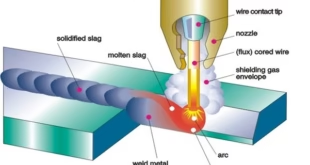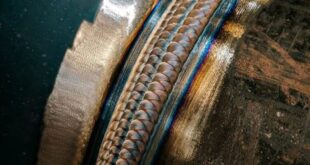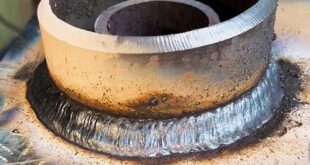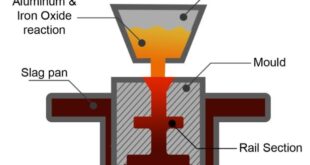What is Roll Welding?
Roll welding is a welding technique that involves the joining of two metal components by rotating them against each other while applying pressure and heat. It is commonly used in various industries for the fabrication of pipes, tubes, and other cylindrical structures.
Roll welding is important because it allows for the efficient and high-speed joining of metal components. By rotating the components, a continuous welding seam can be achieved, eliminating the need for repeated start and stop motions. This results in increased productivity and reduced welding time.
The applications of roll welding are diverse and can be found in industries such as manufacturing, automotive, and aerospace. In the manufacturing industry, roll welding is used for the production of pipes and tubes, allowing for the creation of long, seamless structures with superior strength and durability. It is also employed in the joining of metal sheets and plates, enabling the fabrication of large structures or the repair of damaged components.
In the automotive industry, roll welding is utilized in the production of exhaust systems, where it ensures airtight and durable connections between the components. Additionally, it is employed in joining chassis components, providing strength and stability to the vehicle’s frame.
Roll welding also finds extensive applications in the aerospace industry. It is used in the fabrication of aircraft parts, such as fuel tanks, where reliable and leak-free joints are essential for safety. Furthermore, roll welding is employed in the joining of aluminum and titanium components, which are widely used in aerospace due to their lightweight and high strength properties.
The importance of roll welding lies in its ability to streamline the welding process, improve efficiency, and produce high-quality welds. By reducing the need for multiple starts and stops, it minimizes the risk of defects and ensures consistent and reliable joints. Roll welding offers numerous advantages in terms of productivity and quality, making it a valuable technique in various industrial applications.
Basic Concepts of Roll Welding
Welding is a process of joining two or more materials, typically metals, by applying heat, pressure, or a combination of both. It enables the fusion of the materials at the joint, resulting in a strong and continuous bond.
Roll welding is a specific welding technique that involves the rotation of two metal components against each other while applying pressure and heat. The rotating motion allows for a continuous welding seam to be formed, eliminating the need for frequent starts and stops in the welding process.
In roll welding, several key components and equipment are utilized to facilitate the welding process. These include:
- Rollers: Rollers are an essential component of roll welding. They are used to hold and rotate the metal components during the welding operation. The rollers can be designed to rotate either one or both of the components, depending on the specific welding technique employed.
- Power sources: Power sources, such as electric or gas-powered welding machines, are required to generate the heat necessary for the welding process. These power sources provide the electrical current or heat energy that is transferred to the welding electrodes.
- Electrodes: Electrodes are used to conduct the electrical current or deliver the heat to the joint area. In roll welding, various types of electrodes can be employed, including consumable and non-consumable electrodes. The selection of electrodes depends on factors such as the materials being welded and the desired welding characteristics.
- Shielding gases: Shielding gases are often used in roll welding to protect the welding zone from atmospheric contamination and oxidation. These gases create a protective environment around the weld, preventing the formation of unwanted impurities and ensuring the quality of the welded joint. Common shielding gases used in roll welding include argon, helium, and carbon dioxide.
These key components and equipment play a crucial role in facilitating the roll welding process. They enable the rotation, heat generation, electrical conductivity, and protection required to achieve strong and reliable welds. By understanding and utilizing these components effectively, roll welding can be carried out efficiently and with optimal results.
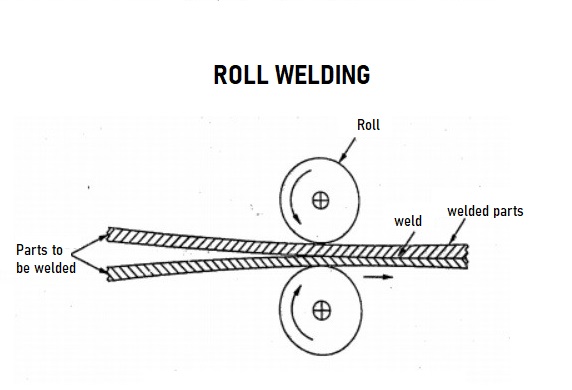
Roll Welding Techniques
Roll welding encompasses various techniques, two of which are friction roll welding and cold roll welding.
Friction Roll Welding
Friction roll welding is a roll welding technique that involves the application of frictional heat to generate the necessary heat for welding. The process begins by rotating the metal components against each other with a controlled pressure. The friction generated between the rotating surfaces produces heat, causing the material at the joint interface to soften and eventually reach a plastic state. As the rotation continues, the softened material fuses together, forming a solid weld joint. Friction roll welding is commonly used for joining cylindrical components, such as pipes and tubes.
Advantages of friction roll welding include high welding speeds, minimal heat-affected zone, and the ability to join dissimilar materials. Since friction is the primary heat source, the welding process is quick, allowing for fast production rates. Additionally, the localized heat input results in a small heat-affected zone, minimizing distortion and preserving the material’s properties. Friction roll welding also enables the joining of different materials, expanding its applicability in various industries.
However, friction roll welding has certain disadvantages. It requires high initial setup costs due to the specialized equipment and tooling needed. The process is also limited to materials that can generate sufficient frictional heat, which may restrict its application range.
Cold Roll Welding
Cold roll welding, on the other hand, is a roll welding technique that does not involve the application of external heat. Instead, pressure is applied to the rotating metal components to create a solid-state weld. The pressure causes the materials to deform and form a bond at the interface. Cold roll welding is commonly used for joining thin metal sheets, wires, or other components where the introduction of heat could be detrimental.
The advantages of cold roll welding include its simplicity, cost-effectiveness, and the ability to join dissimilar materials. As no external heat is applied, there is no need for complex heat sources or shielding gases. Cold roll welding is a relatively straightforward process, making it accessible and cost-effective. It also enables the joining of dissimilar materials, expanding the range of applications.
However, cold roll welding has limitations. It is primarily suitable for thin materials due to the lower energy input and pressure required. It may not be suitable for thick or heavy components that require a stronger weld joint. Additionally, the absence of heat input may result in a weaker weld strength compared to other welding techniques.
Understanding the processes, advantages, and limitations of friction roll welding and cold roll welding helps determine the most appropriate technique for specific applications, considering factors such as material type, joint requirements, and production considerations.
Roll Welding Applications
Roll welding has wide-ranging applications in various industries, including manufacturing, automotive, and aerospace.
In the manufacturing industry, roll welding is extensively utilized in the production of pipes and tubes. The continuous rotating motion allows for the seamless joining of metal components, resulting in strong and durable cylindrical structures. Roll welding ensures the production of high-quality pipes and tubes with consistent wall thickness, making them suitable for applications in plumbing, construction, and transportation sectors.
Another application of roll welding in the manufacturing industry is the joining of metal sheets and plates. By rotating and applying pressure, roll welding enables the creation of continuous weld seams along the length of the joined components. This technique is beneficial for the fabrication of large structures, such as storage tanks, pressure vessels, and structural frameworks.
In the automotive industry, roll welding plays a crucial role in the production of exhaust systems. The rotation and pressure applied during roll welding ensure airtight and leak-free joints, preventing the escape of exhaust gases. The resulting welds exhibit excellent strength and durability, meeting the rigorous demands of automotive applications.
Additionally, roll welding is utilized in the automotive industry for the joining of chassis components. By creating continuous welds, it contributes to the structural integrity and stability of the vehicle’s frame. Roll welding ensures strong connections between different chassis components, enhancing the overall safety and performance of the automobile.
The aerospace industry also benefits from roll welding techniques. It is employed in the fabrication of aircraft parts, particularly those requiring cylindrical or tubular structures. Roll welding enables the production of seamless components with high integrity, such as fuel tanks and hydraulic tubing systems. The continuous welds achieved through roll welding ensure the reliability and durability of these critical aerospace components.
Furthermore, roll welding finds extensive application in the aerospace industry for the joining of aluminum and titanium components. Aluminum and titanium alloys are commonly used in aerospace due to their lightweight properties and high strength-to-weight ratios. Roll welding allows for the efficient joining of these materials, ensuring the structural integrity of various aircraft components, including wing structures, fuselage sections, and engine components.
The diverse applications of roll welding in manufacturing, automotive, and aerospace industries highlight its significance in enabling efficient and reliable joining of metal components. The technique’s ability to create continuous welds, its strength and durability advantages, and its suitability for various materials make it a valuable process for a range of industrial applications.
Advantages and Disadvantages of Roll Welding
Roll welding offers several advantages that contribute to its popularity in various industries:
- High welding speed: Roll welding is known for its high welding speed compared to traditional welding methods. The continuous rotation and pressure application allow for efficient and rapid joining of metal components. This increased speed enhances productivity and reduces overall production time.
- Improved material utilization: Roll welding minimizes material waste by creating a continuous weld seam along the length of the joint. Unlike conventional welding techniques that require intermittent starts and stops, roll welding maximizes material utilization, resulting in cost savings and reduced material waste.
- Reduced heat-affected zone: Roll welding generates localized heat, which results in a smaller heat-affected zone (HAZ) compared to other welding processes. The reduced HAZ helps maintain the material’s mechanical properties, such as strength and hardness, and minimizes distortion or warping of the welded components.
However, roll welding also has certain disadvantages that need to be considered:
- Limited applicability to certain materials: Roll welding may not be suitable for all types of materials. The technique works best with materials that can generate sufficient frictional heat or withstand the pressure applied during the process. It may not be suitable for materials that are highly sensitive to heat or have poor thermal conductivity.
- Higher initial setup cost: Implementing roll welding often requires specialized equipment and tooling, which can result in higher initial setup costs compared to conventional welding methods. The cost of acquiring and maintaining the necessary machinery and components can be a significant investment for some businesses.
Understanding the advantages and disadvantages of roll welding allows industries to make informed decisions about its suitability for specific applications. While the technique offers notable benefits in terms of speed, material utilization, and heat-affected zone reduction, the limitations regarding material compatibility and initial setup costs should be considered when evaluating its feasibility for a particular welding project.
Safety Considerations in Roll Welding
Safety considerations are paramount in roll welding to protect the welders and ensure a safe working environment. Several safety measures should be implemented, including the following:
Personal protective equipment (PPE)
Welders involved in roll welding should wear appropriate personal protective equipment to safeguard against potential hazards. This includes wearing welding helmets with protective lenses to shield the eyes and face from sparks, radiation, and flying debris. Additionally, welders should wear fire-resistant clothing, gloves, and safety shoes to protect against burns, sparks, and falling objects.
Proper ventilation and fume extraction
Roll welding generates fumes and gases that can be hazardous if inhaled. Adequate ventilation and fume extraction systems should be in place to ensure the removal of welding fumes from the work area. This helps to maintain air quality and protect welders from respiratory issues and other health risks associated with exposure to welding fumes.
Electrical safety precautions
Roll welding involves electrical equipment and power sources, requiring strict adherence to electrical safety precautions. Welding machines should be properly grounded and regularly inspected to ensure their safe operation. Welders must follow electrical safety guidelines to prevent electric shock and other electrical hazards. This includes avoiding contact with live electrical parts, using insulated tools, and ensuring proper wiring and connections.
Regular training and education on safety procedures and practices are essential for welders engaged in roll welding. They should be well-versed in the proper use of personal protective equipment, the importance of ventilation and fume extraction, and the necessary precautions to take regarding electrical safety.
By implementing these safety considerations, industries can create a safer work environment for welders, reduce the risk of accidents and injuries, and promote the overall well-being of the workforce involved in roll welding operations.
FAQs
What is a roll welding?
Roll welding is a welding technique that involves rotating two metal components against each other while applying pressure and heat to create a continuous weld seam.
What is the working principle of roll welding?
The working principle of roll welding is based on the rotation and pressure applied to the metal components. This generates frictional heat, softening the material at the joint interface. As the rotation continues, the softened material fuses together, forming a solid weld joint.
What are the different types of roll welding?
The different types of roll welding include friction roll welding and cold roll welding.
What is the process of cold roll welding?
The process of cold roll welding involves joining metal components without the application of external heat. Pressure is applied to the rotating components, causing them to deform and form a bond at the interface.
What is rolling process and its types?
Rolling is a metalworking process that involves passing a metal stock through a pair of rotating rolls to reduce its thickness or change its shape. The types of rolling processes include hot rolling and cold rolling.
What are rolling defects?
Rolling defects refer to imperfections that can occur during the rolling process. Examples of rolling defects include surface cracks, edge cracks, scale formation, and shape defects.
What is the difference between hot and cold rolled welding?
The difference between hot and cold rolled welding lies in the temperature at which the rolling process takes place. Hot rolled welding involves rolling the metal at a high temperature, while cold rolled welding is performed at room temperature or below.
Why is it called cold welding?
Cold welding is called so because it is a process of joining metal components without the need for external heat. The bond is formed solely through pressure and deformation of the materials, resulting in a solid-state weld.
What is hot and cold rolling process?
Hot rolling process involves heating the metal above its recrystallization temperature and then passing it through a pair of rolls to shape it or reduce its thickness. Cold rolling process, on the other hand, is performed at room temperature or below, without heating the metal, to achieve desired shape or thickness.
Conclusion
In conclusion, roll welding is a welding technique that involves the rotation of metal components against each other while applying pressure and heat. Friction roll welding and cold roll welding are two commonly used roll welding techniques.
Roll welding offers several advantages, including high welding speed, improved material utilization, and reduced heat-affected zone. These benefits make it a valuable process in industries such as manufacturing, automotive, and aerospace.
In the manufacturing industry, roll welding is utilized for the production of pipes and tubes, as well as joining metal sheets and plates. In the automotive industry, it is essential for the production of exhaust systems and joining chassis components. In the aerospace industry, roll welding is employed in the fabrication of aircraft parts and joining aluminum and titanium components.
Roll welding is expected to continue playing a significant role in the welding industry. Advancements in equipment and technology may further enhance the efficiency and effectiveness of roll welding processes. Additionally, research and development efforts may focus on expanding the applicability of roll welding to a wider range of materials and exploring new techniques that offer even greater advantages.
 Welding of Welders All about Welding and Welders
Welding of Welders All about Welding and Welders
